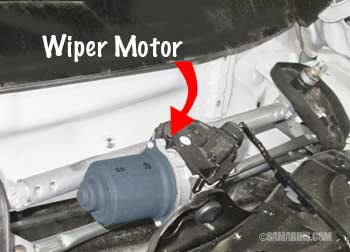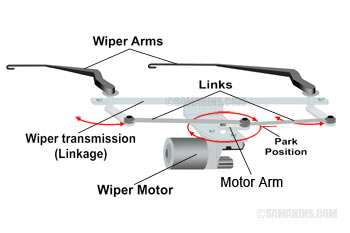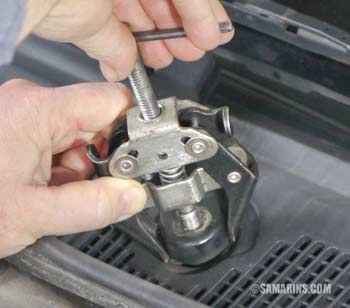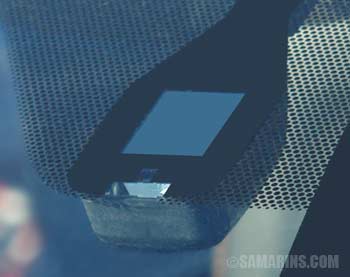Wiper motor, linkage: how it works, symptoms, problems, testing
Updated: July 21, 2021
Working windshield wipers are vital for driver visibility. The vehicle is considered unsafe if the wipers don't work. The front wiper motor and the wiper transmission mechanism (linkage) are installed below the windshield, under the cowl panel cover. How the wiper system works: when you turn the wiper on, the wiper switch sends the signal to the control module. The control module operates the wiper relay. The relay sends 12-volt power to the wiper motor. The motor rotates a little arm (see the diagram) that through links moves the wiper arms. Read more details below.
If your wipers don't work, your mechanic or dealer will need to diagnose the problem first, then order the part that has failed. This means there is a chance your car won't be repaired on the same day. The repair cost depends on the problem. Diagnosing wiper motor problems is not very difficult, please read further. We also found several recalls related to windshield wipers. Read the recalls section.
Why wipers don't work: troubleshooting tips
The first thing your mechanic would want to know is it a mechanical problem with a wiper transmission (linkage) or an electrical problem with a wiper motor circuit. How can you tell? Does the wiper motor run or at least make any noise when the wiper switch is on? If the motor runs or tries running, but the wipers don't work, it's a mechanical problem with the linkage, see common problems below. If the motor doesn't react when the switch is operated, it's an electrical problem. The wiper motor circuit will need to be tested; more details below.Common problems with a transmission mechanism (linkage)
The wiper arm shaft seizes up inside the linkage. The wiper linkage, also known as wiper transmission or wiper link assembly, has two shafts that hold the wiper arms. Often, one of the shafts seizes up, it's a common problem in many cars. First, wipers start moving slower, then seize up completely.If it's possible to free wiper arm shafts out of the linkage, your mechanic may suggest an option to clean and lubricate the shafts without replacing parts. It is cheaper, but the proper solution is to replace the linkage.
Replacing the linkage is not very expensive: $35-$130 part plus $80-$160 labor. In some cases, the seized-up wiper arm shaft can cause the wiper motor to overheat and stop working. In this case, the wiper motor will also need to be replaced ($35-$169 part). See how to test a wiper motor below.
One of the links separates. The links have plastic or rubber sockets at each end that connect to the crank arms via ball joints. If worn out or rusted, the link can pop out, see this photo. This will cause one or both wipers not to operate. The clanking noise coming from the wiper motor area when wipers operate is one of the early symptoms of a worn-out link or other component of the transmission. Another symptom is when one of the wiper arms feels loose or swings too far.
Advertisement
The nut that holds one of the wiper arms comes loose. When one of the nuts that holds a wiper arm comes loose, one of the arms stops working completely or shifts away from its proper position. The fix is simple, the loose wiper arm needs to be repositioned correctly and both wiper arm nuts need to be re-tightened.
Both wipers work, but stop in the wrong position This can happen for a number of reasons. Sometimes the little motor arm that is connected to the wiper motor gets loose and shifts on the motor shaft, causing it not to stop in the correct 'Park' position (see the diagram above).
How the wiper motor and circuit work
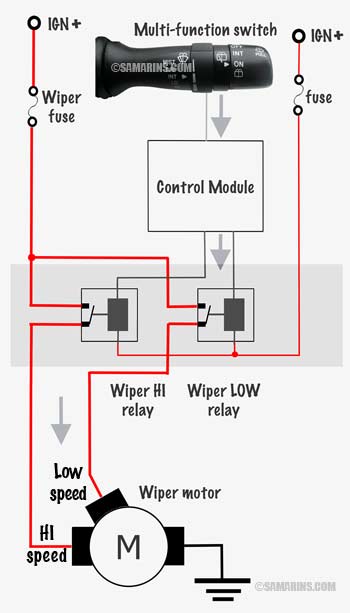 Wiper motor electric diagram.
Wiper motor electric diagram. The wiper switch on the steering column (multifunction switch) commands the control module and the control module operates the wiper motor through wiper motor relays; see the diagram.
There could be up to 3 relays: one for the wiper motor high speed circuit, one for the low-speed circuit and one for the intermittent wipers circuit. The diagram is not the same for all cars. Check the service manual for your particular vehicle. We posted a list of websites that offer paid access to service manuals for different cars at the bottom of this article.
When troubleshooting a problem with the wipers, mechanics at a dealership can access the control module with a scan tool that can show if the multifunction switch operates properly. A scan tool also allows an active test, which means the wiper motor can be activated from the scan tool.
The wiper motor is a DC (direct current) 12V motor that includes a set of gears and a park switch. The park switch allows the motor to stop when wipers are positioned at the bottom of the windshield in their "park' position.
Wiper relay
Wiper relays can be installed in the fuse box under the hood or in other locations. In some cars a wiper relay is built inside the Body Control Module (BCM). It's not uncommon for a wiper relay to fail or stick, causing the wiper motor not to work or work with the switch turned off. We have seen a wiper relay sticking after wipers were turned on while being frozen to the windshield. When wipers are turned on while frozen, the high current can damage the relay or the wiper motor itself. It's one of the reasons why it's always recommended cleaning the windshield from the snow before driving or turning on the wipers.How does the rain sensing wipers work?
A rain sensor is often installed on the inside of the windshield. It measures the reflection from the windshield. When it rains, the reflection changes and the sensor sends the signal to the BCM. If the wiper switch is in "Auto" mode, the BCM turns on the wipers. In many cars with this option, the rain-sensing wipers function can be enabled or disabled through the infotainment system.If the rain-sensing wiper function doesn't work, while everything else is working, the rain sensor needs to be inspected first. Some cars have a transparent rubber gasket between the sensor and the windshield. Often rain sensor problems are caused by this gasket falling out of place or not sitting properly. Sometimes you can see the gasket is not sitting flush with the windshield.
How is the wiper motor circuit tested?
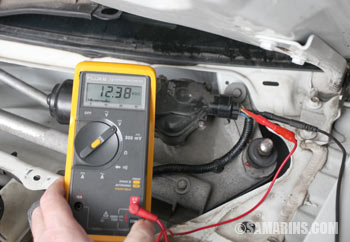 The multimeter shows 12.38 Volt, but the motor doesn't run. This means the wiper motor is bad and needs to be replaced.
The multimeter shows 12.38 Volt, but the motor doesn't run. This means the wiper motor is bad and needs to be replaced.The diagnostic procedure for this car recommends checking the ground and ignition voltage at the wiper motor connector. We check the voltage with a multimeter. It shows 12V, see the photo. The connector looks OK, there is no corrosion. If there is 12 Volts at the motor, but it doesn't run, the wiper motor is bad and needs to be replaced. Replacing a wiper motor costs $42-$168 part plus $80-$180 labor. Watch these YouTube videos on how to test a wiper motor.
Wiper motor park switch
A problem with the wiper motor park switch can cause the wipers not to turn off or park in random spots. It might happen intermittently, often in cold weather. Some Honda and Acura cars had this problem. The park switch is built into the wiper motor, but in some cars, parts related to the parking switch come separately. In most cars, the park switch comes together with the motor, so if the park switch is bad, the wiper motor must be replaced.Problems with a multifunction switch
Problems with a multifunction switch can cause the wiper motor to work in some modes, but not to work in others. For example, in some Ford trucks, a bad multifunction switch was known to cause the wipers to operate in the low/intermittent mode even after the switch is turned off.Wiper motor recalls
Working windshield wipers are important for safe driving. Several manufacturers have issued recalls related to the wiper system and possibly more recalls will come in the future. This means, if you have to pay for wiper motor repairs, keep the receipt. If there is a recall, you can apply for reimbursement. Here are the recalls we found. To check if your car has a recall, visit Safercar.gov.Chrysler issued the safety recall K24 for the 2008 Jeep Liberty.
Honda recalled the 2003 4-door Honda Accord for windshield wiper motor failures (service bulletin 08-043).
GM issued the recall 25302 to address corrosion failure of the front wiper transmission in the 2013 Chevrolet Equinox and GMC Terrain.
Toyota released a recall F0S for Wiper Motor Link Corrosion in the 2009-2012 North American RAV4.
Mitsubishi recalled the 2007-2013 Outlander for wiper motor failures (recall SR-17-003). Another Mitsubishi recall (SR-16-010) covers a wiper motor in the 2011−2015 Outlander Sport / RVR.
Subaru recalled certain 2010-2014 Legacy and Outback vehicles to replace the front windshield wiper motor bottom cover (bulletin WTK-71).
Read Next:
Why a windshield washer doesn't work - troubleshooting tips
How to check a fuse
Check Engine light: what to check, common problems, repair options
Car won't start: 3 common causes. Steps to diagnose
Window regulator, window motor: problems, testing, replacement
How car parts and sensors work
Why a windshield washer doesn't work - troubleshooting tips
How to check a fuse
Check Engine light: what to check, common problems, repair options
Car won't start: 3 common causes. Steps to diagnose
Window regulator, window motor: problems, testing, replacement
How car parts and sensors work
